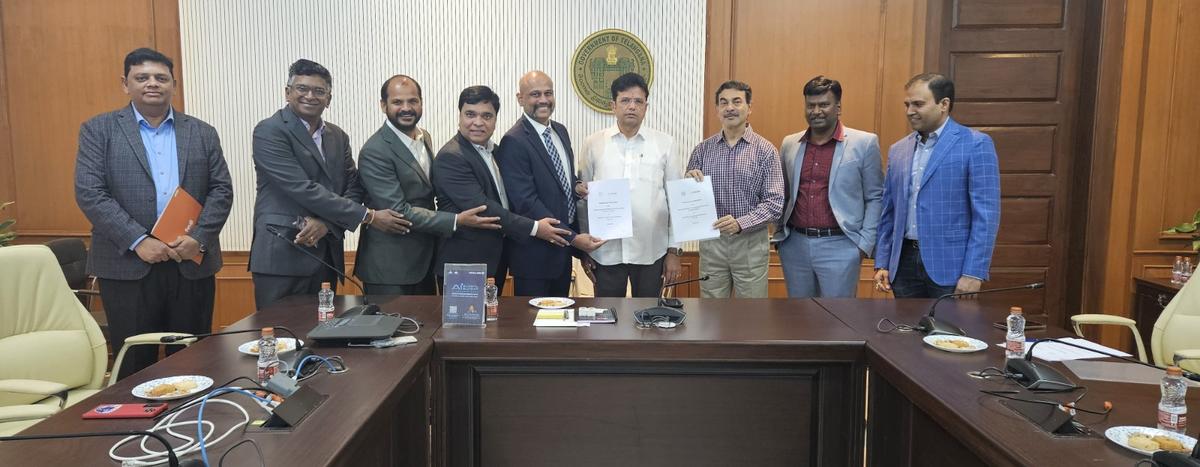Every morning, G. Deepa zips through Warangal’s quiet lanes on her scooter — a 10-km ride from her home in TNGO’s Colony to the Madikonda IT SEZ. Fifteen minutes later, she is at her desk, having cruised through roads blissfully free of gridlock and honking, miles away from Hyderabad’s chaos yet firmly within Telangana’s growing tech map.
For the 22-year-old B.Tech graduate, working in her hometown isn’t just convenience, it is necessity. “My parents are not comfortable sending me to Hyderabad or any other city since they are concerned about my safety. So I decided to look for job opportunities in Warangal itself,” says Deepa, who earns ₹15,000 a month. Her father works as a driver-cum-office attendant in a chit fund firm and her mother is a homemaker.
Also Read | NITWIEF supports 35 startups, aims to ignite entrepreneurial spirit
It is a modest start to her career, but one that tells a larger story: of how Warangal, Telangana’s second-largest city, is quietly becoming the face of the State’s Tier-2 IT revolution.
The transformation began at the Madikonda IT SEZ, a 45-acre hub — 35 acres SEZ and 10 acres non-SEZ — on the outskirts of Kazipet, a suburb of Warangal and 135 kilometres from State capital Hyderabad.

Conceived in 2008, it saw its first 15,000 sq.ft. incubation centre rise in 2015, followed by another of equal size in 2017. Today, the campus houses firms like Cyient, Quadrant Resource, Ventois Software Solutions, Genpact and Kakatiya IT Solutions, together employing nearly 1,000 professionals. Quadrant Resource, with a 50,000-sq.ft. facility, is the second-largest company at Madikonda after Cyient.
Hyderabad-based multinational tech company Cyient established its offices at the government’s IT incubation centre here in 2016 and inaugurated its state-of-the-art development centre in January 2020. Spread over 60,000 sq.ft., it can accommodate up to 600 engineers.
“We currently have over 200 associates working at our Warangal Development Centre, and there is ample scope for further expansion,” says P.N.S.V. Narasimham, president and head of Corporate Functions at Cyient. “The growth here has been steady, in line with our Tier-2 city strategy. We plan to continue recruiting from the local talent pool,” he adds.
Government officials say this momentum is part of a deliberate shift. “The State is encouraging both startups and larger firms to expand into Tier-2 and Tier-3 cities,” explains Ajmeera Swamy, zonal manager of Telangana State Industrial Infrastructure Corporation, who is also overseeing the second-phase IT Tower construction in Khammam.
Across Telangana, eight IT towers — in Warangal (phases I and II), Nalgonda, Mahabubnagar, Nizamabad, Karimnagar, Khammam and Siddipet — are already operational, hosting 85 companies and over 3,000 professionals.
Together, these hubs are central to Telangana government’s plan to spread employment beyond Hyderabad. The firms operating from them are increasingly hiring across disciplines, from B.Tech graduates to other qualified youth with relevant technical skills.
The growth, however, comes with its own contrasts. Shyam Kumar, a resident of Hanamkonda in Warangal, says he had to send his daughter to Hyderabad, where she earns almost double of what Warangal firms offer. Yet for others, like Pankaj, a mid-level executive who recently moved back to his hometown, the trade-off is worth it. “I chose to come back for a better work-life balance,” he says.
A recent study by NASSCOM, the apex body for technology industry in India, supports the trend: over 35% of India’s new engineering graduates now come from Tier-2 and Tier-3 cities, and more are choosing to stay back when viable jobs are available locally.
Sensing this shift, Minister for IT and Industries D. Sridhar Babu says several firms are keen to invest in smaller cities, citing HC Robotics’ ₹500-crore plan that promises 2,500 jobs over the next three years.
Policy framework and incentives
The Telangana government’s proactive policies have been key to attracting IT and ITeS firms to regional hubs. Its incentive structure leaves little to chance — companies operating from government-built IT Towers enjoy rent-free facilities for the first three years, while land is allotted at concessional rates. Firms also benefit from industrial power tariffs and 100% reimbursement of stamp duty and registration charges.
For those expanding into Tier-II cities, the bouquet of incentives widens further, from municipal tax exemptions and recruitment subsidies to dedicated infrastructure support. Startups, women entrepreneurs and those from Scheduled Caste (SC) and Scheduled Tribe (ST) communities receive tailor-made packages and fast-track clearances through a single-window system.
Connectivity and digital readiness form the backbone of this strategy. Projects such as T-Fiber, which deliver high-speed broadband access across the State, have digitally empowered smaller cities, equipping them to meet the demands of modern, tech-driven enterprises.
“Telangana’s measures have created a business-friendly ecosystem that encourages investment and sustains employment creation across regions,” says Sreekant Lanka, Chief Strategy Officer of the Department of Information Technology, Electronics and Communications.
The State is now steering a decisive shift from a Hyderabad-centric model to a more distributed IT landscape. IT and Industries Minister D. Sridhar Babu is driving a vision of technology-led growth that takes opportunities to the grassroots through IT Towers, incubation centres and innovation hubs.
“Telangana aims to ensure that growth and opportunities reach every corner of the State, not just Hyderabad. We are strengthening support for industries to invest and thrive in Tier-2 and Tier-3 cities by improving infrastructure, fostering innovation and building local skills. Our goal is to make every investment count, creating jobs, empowering communities and driving balanced growth across the State,” says Sridhar Babu.
This is a marked departure from Telangana’s early IT trajectory, when growth was confined almost entirely to Hyderabad. The government’s current focus on nurturing smaller cities as self-sustaining technology ecosystems is not just about economic expansion; it is about balancing opportunity, reducing urban pressure and giving young professionals like Deepa a reason to stay closer to home.
The flagship of decentralised IT
Once known primarily as an educational hub, Warangal has swiftly evolved into a flagship of Telangana’s decentralised IT growth. “Warangal city has been recognised as an emerging hub for Global Capability Centres (GCCs), supported by a skilled talent pool, proximity to Hyderabad and affordable real estate,” an official points out.

Telangana Industrial Infrastructure Corporation zonal manager Ajmeera Swamy who is also overseeing the second-phase IT Tower construction in Khammam.
| Photo Credit:
NAGARA GOPAL
Educational institutions such as the National Institute of Technology (NIT)-Warangal have been instrumental in this transformation, supplying trained manpower, driving research collaborations and nurturing innovation. The city’s ecosystem now attracts a diverse mix of startups and established technology players, signalling its arrival as a credible alternative to Hyderabad.
“The Ministry of Electronics and Information Technology is implementing GENESIS (GEN-NEXT Support for Innovative Startups) scheme, which funds innovative startups with grants of up to ₹10 lakh a year. The aim is to boost the startup ecosystem in Tier-2 and Tier-3 cities,” explains NIT-Warangal director Bidyadhar Subudhi.
Companies such as Cyient view Warangal as a natural extension of Hyderabad’s strengths. “While Hyderabad remains an attractive destination for most fresh graduates and many of our clients, a city like Warangal complements it by enabling us to train and certify professionals across multiple domains,” asserts Narasimham.
Recognising that skilled manpower is the backbone of IT expansion, Telangana launched the Telangana Academy for Skill and Knowledge (TASK) to bridge the gap between academia and industry.
TASK partners with over 760 engineering and degree colleges, offering specialised training in artificial intelligence, data analytics, cloud computing and cybersecurity alongside workplace readiness and soft skills. To date, it has trained over 9.8 lakh students and 18,650 faculty members, facilitating more than 35,000 job placements through partnerships with 80 industries.
By aligning academic curricula with evolving industry needs, TASK has empowered companies to recruit locally, thereby reducing dependence on metropolitan talent and helping smaller cities such as Warangal sustain their IT momentum.
“Salaries for fresh graduates in Telangana’s Tier-2 cities typically range from ₹13,000 to ₹20,000 per month. While compensation package is lower compared to Hyderabad, employee retention is higher due to shorter commutes, lower living costs and better work-life balance. This combination of sustainability and stability makes Tier-2 centres appealing for companies aiming for long-term operations,” says an official.
However, challenges persist. In Karimnagar, where the IT Tower was inaugurated in July 2020, nearly half of the 81,000 sq. ft. built-up area remains unoccupied. Of the 550 available seats, only 220 are currently in use. Sources point to a mix of post-pandemic slowdown and operational factors, including maintenance issues and staff attrition, as reasons for the underutilisation.
Even so, local employees see the initiative as transformative. “The IT Tower is an asset to Karimnagar,” says Lakshmi, 27, a senior executive at one of the firms. “It allows us to pursue our careers while staying close to our families.”
Others emphasise the lifestyle advantages. “Short commute and peaceful environment improve productivity,” notes Samson, 28, a digital marketing analyst.
In Khammam, the first phase of the IT Hub inaugurated in December 2020 reached full occupancy within months. The second phase, featuring 55,000 sq. ft. of built-up space, is now under construction. “The second phase should be expedited to create the ecosystem necessary for startups and employment,” says Democratic Youth Federation of India district president Ch. Ramesh.
Preparing for AI era
The next phase of Telangana’s IT expansion will be shaped by artificial intelligence (AI) and automation, and these technologies are poised to reshape service delivery and operational efficiency across sectors.
To prepare for this shift, the State has rolled out a range of future-oriented initiatives. The Young India Skills University, established under public-private partnership, offers industry-aligned training to rural and semi-urban youth. Complementing this, the government is setting up an AI University to equip professionals with advanced expertise in artificial intelligence and emerging technologies.
Officials say the State is also fostering ‘AI readiness’ within government departments, by training officers in data analytics, AI fundamentals and agile project development. Collaborations with global institutions, including Australia’s Deakin University, aim to strengthen research, innovation and entrepreneurship in these cutting-edge fields.

IT and Industries Minister D.Sridhar Babu, Special CS-IT and Industries Jayesh Ranjan and officials with representatives of ITServe Alliance at the MoU-signing in Hyderabad last December.
| Photo Credit:
File Photo
“Skilling is a top priority for Telangana and for good reason. Initiatives such as TASK, Young India Skills University and the upcoming AI University are equipping youth in smaller cities with the capabilities to participate in emerging industries. This not only opens better opportunities for local talent today but also lays the foundation for long term growth and sustained investments beyond Hyderabad,” says Lanka.
Narasimham says AI training is now being extended across all company locations, including Tier-2 centres: “With virtual tools and certification systems, we are able to train associates in emerging technologies with greater ease.”
Utilisation of IT infrastructure, however, remains uneven despite steady progress. Several towers continue to operate below capacity, highlighting the need for stronger post-inauguration strategies, including better maintenance, faster approvals and improved integration with local educational institutions.
Telangana’s decentralised IT model is closely aligned with the national push for technology-driven growth. A mix of targeted incentives, regional infrastructure and focused skilling programmes is creating a self-sustaining IT network across smaller cities. While challenges such as underutilisation and workforce migration persist, confidence in the capacities of Tier-2 and Tier-3 cities is steadily rising.
Each IT Tower, developed at costs ranging from ₹25 crore to ₹45 crore, accommodates between 500 and 1,000 employees. These ready-to-occupy facilities feature modern amenities, reliable digital connectivity and uninterrupted power supply.
In a further push to expand IT reach into remote regions, a G+4 IT tower is coming up at Battisavargon village in Adilabad district in northern part of the State. Spread over three acres with a built-up area of 68,000 sq.ft. and costing ₹58 crore, it is expected to be completed in three months, bringing the promise of high-quality jobs and digital infrastructure to one of Telangana’s more distant towns.
Wider strategy and national context
Telangana’s efforts mirror a broader national trend of IT decentralisation. A joint report by Nasscom and Deloitte India notes that the technology sector in India has expanded from seven major hubs — Delhi, Bengaluru, Chennai, Hyderabad, Kolkata, Mumbai and Pune — to 26 smaller cities, including Warangal, Vijayawada (Andhra Pradesh), Mysuru (Karnataka), Kochi (Kerala), Coimbatore (Tamil Nadu), Lucknow (Uttar Pradesh) and Guwahati (Assam).
But Telangana is aiming higher than the conventional Tier-2 model. The government plans to extend IT infrastructure into towns such as Adilabad, Ramagundam and Wanaparthy, with expansion guided by company demand and the availability of local talent, according to officials in the Information Technology, Electronics and Communications Department.
The Nasscom-Deloitte report, which studied 19 companies, highlighted the main hurdles in Tier-2 locations: limited exposure and unsatisfactory English communication skills among candidates, limited access to diverse skill sets, fewer opportunities for career growth leading to employee migration, and a shortage of talent in mid-level and senior-level leadership.
To address these gaps, Telangana government signed a memorandum of understanding with ITServe Alliance, a US-based IT industry association, in December last year. The partnership aims to generate 30,000 IT jobs across Tier-II and Tier-III cities, while promoting the establishment of IT and related industries in towns such as Mahbubnagar, Warangal, Karimnagar, Khammam and Nizamabad among other emerging urban centres.
Workforce development lies at the centre of this initiative. Through upskilling and reskilling programmes, the government aims to build a strong base of industry-ready talent within local communities. As part of the agreement, Telangana will help ITServe member companies establish operations in smaller cities, while ITServe Alliance will use its network to strengthen local IT ecosystems and create long-term jobs. The State is also drawing foreign tech firms to set up their GCCs, further boosting local employment opportunities.
With targeted skilling, strategic partnerships and a focus on local talent, Telangana is proving that IT growth can be both far-reaching and deeply rooted. The State is turning smaller cities into self-reliant engines of innovation, where careers, communities and commerce flourish together.
(Some names have been changed on request)


